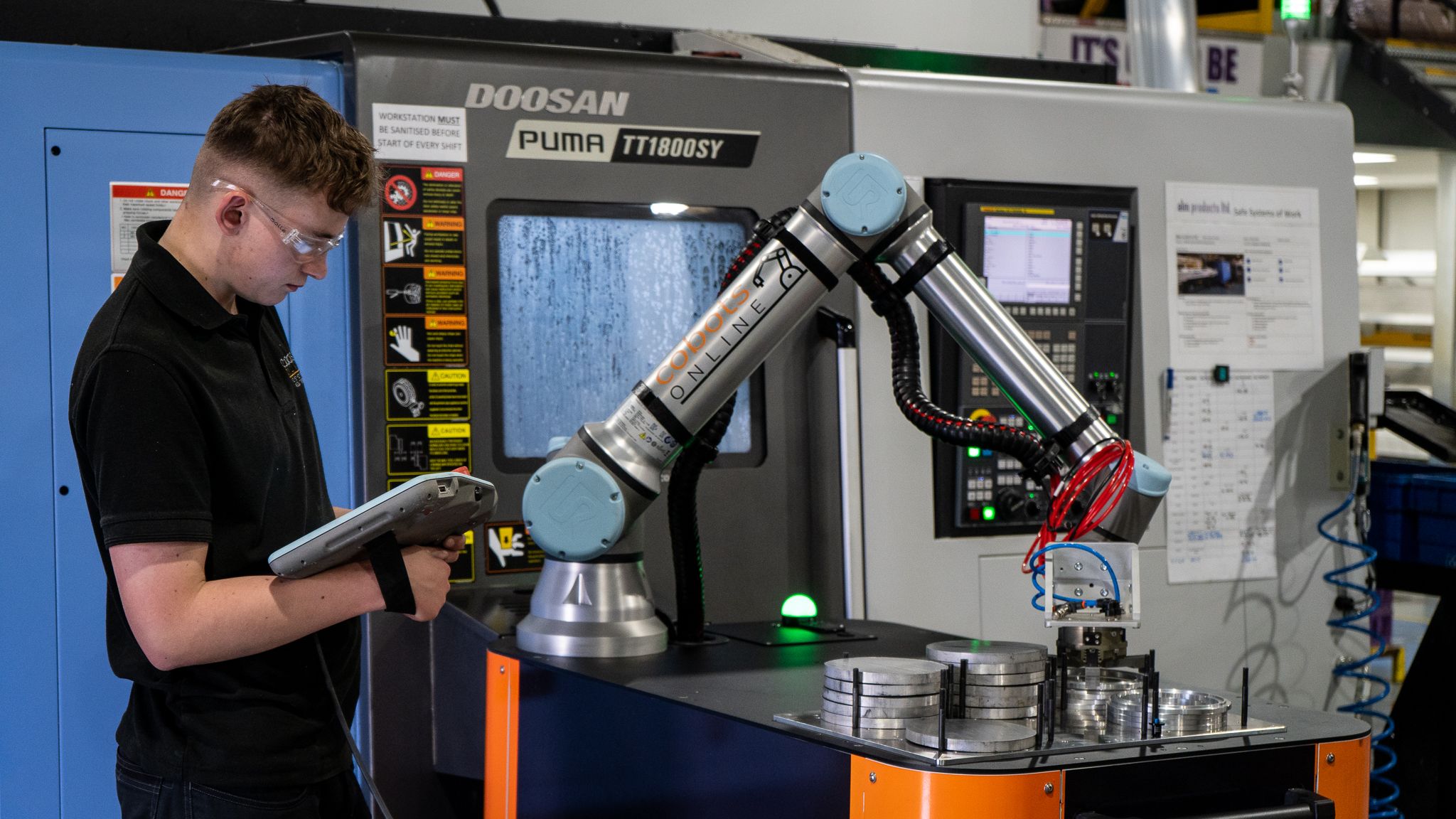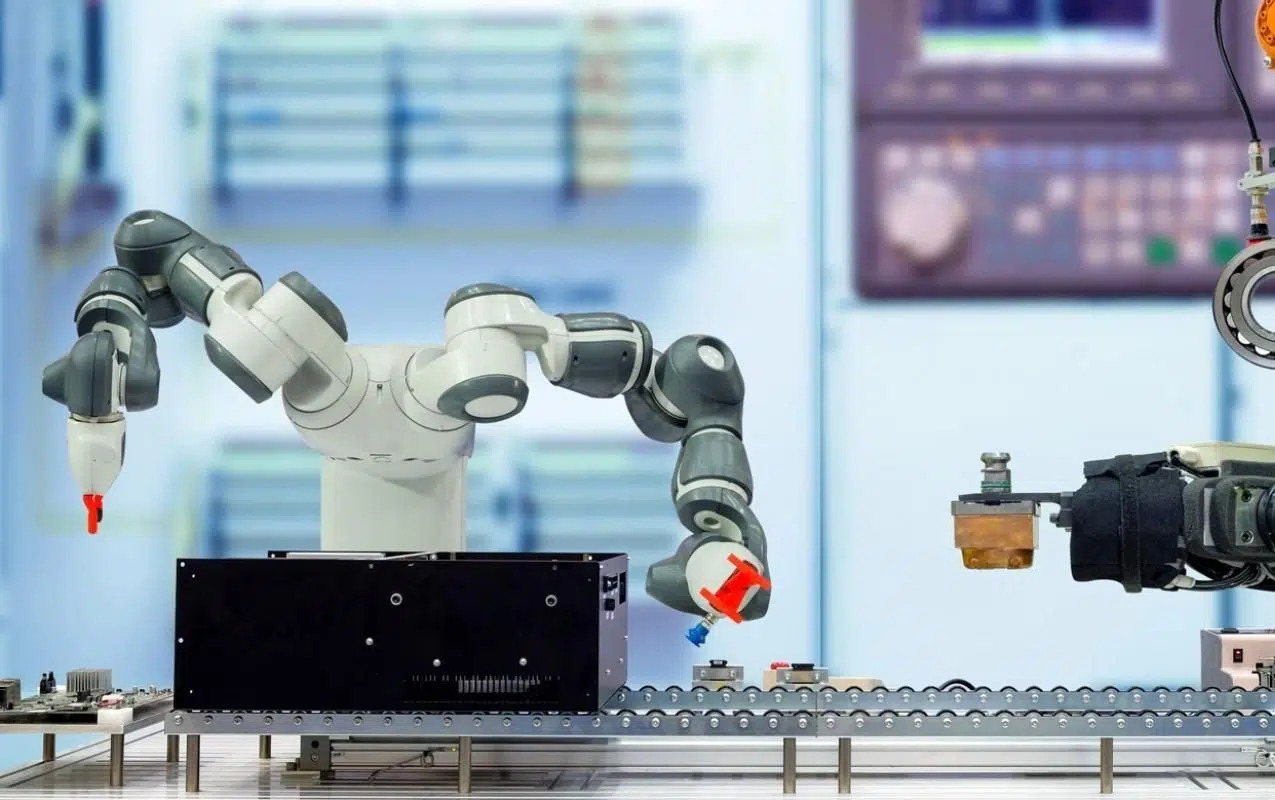The Emergence of Collaborative Robots
A collaborative robot or ‘cobot’ is defined as a robot that has been designed and built to collaborate with humans in a shared work environment. Cobots are the new frontier of the robotics industry.
According to the International Federation of Robotics, cobots that are designed to assist workers in industrial applications currently account for 3% of robot sales globally. However, by 2025, the share is likely to rise to circa 40% with a projected market value of $9 billion.
Sensing the opportunities, EOAT manufacturers are launching new end of arm tooling designs especially for use with cobots.
Robots and humans have been co-workers for years, but rarely have we been truly working together. This is about to change with the rise of collaborative robots. Unlike traditional industrial robots, collaborative robots aren’t placed behind guards or in cages.

Instead, they can be designed to work safely around people as they are designed with multiple advanced sensors, native software and end of arm tooling that help them quickly and easily detect and adapt to any sort of encroachment into its designated work space.
Cobots typically adopt a rounder, more smoother shape without any pinch points or internal wires and motors. They also have the ability to identify any anomalous force applied to their joints while in motion.
They can also be programmed to respond instantly by reversing or stopping positions when they come into a variety of human contact scenarios.
Additionally, programming and integration is made more simple as Cobots can be hand guided. This means a worker can demonstrate the positions/paths that are desired of the robot and they will immediately copy and repeat where necessary.
Applied collaborative robotics can improve application functionality and systematically decrease the amount of work space necessary for a robotic unit. Consequently, collaborative technology is offering huge advantages production lines, workers and business in general.
Human Robot Collaboration
Robots transcend at simple, repetitive tasks involving hand or arm movements. Diversely, humans have unique cognitive skills for understanding and adapting to any changes in a given task. The unique combination of humans and robots can greatly improve production performance, taking into account that the work is optimally shared.
Human/robot collaboration also allows for differing levels of automation and human intervention and designated work tasks can be partially automated if a wholly automated solution is not economical or simply too complex.
Furthermore, non-ergonomic workstations can be greatly improved with the help of robots.
Of course, throughout all robotic processes, safety of the human is paramount and a prerequisite.
Advantages of Collaborative Robots
Take a look at a few of the key differences between a robot and cobot:
Easy Set Up
Collaborative robots are very easy to program and require minimal training. Whereas traditional industrial robots require advanced programming skills and in depth training, cobots can be given work instructions without coding, making deployment and re-deployment especially easy.
Training cobots can be as easy as setting them into servo-assist teach mode and guiding the arm through the tasks, then replaying the outcome. Alternatively, the simple pallet of flow charge functions can be sequenced for a more sophisticated deployment.
Vision as Standard
Although vision systems for robots are not new, integrating them is typically more complicated and less intuitive. A vision system vastly increases the cobot’s range of applications. A built-in vision function has a variety of features such as shape matching, barcode & QR code reading, colour recognition, OCR and are all easily configured from the integral robot design toolbox.
Safe
Industrial robots blindly perform their task until they’re told to stop, which is why they must be confined to cages. Cobots can have pre-set speeds and torques, which can allow them to stop if they detect something in their way. This doesn’t just cut down on accidents, it means that cobots can be deployed within the traditional production working space.
Incredibly Versatile
Because they’re so easy to set up and use they can be deployed wherever you need them and re-deployed quickly and painlessly, unlike older robots that are either purpose-built for a particular task or difficult to adapt to new tasks. Like your flesh-and-blood workforce, cobots can retrained and re-deployed.
More consistent and accurate than humans
Unlike humans, cobots are very accurate. Some cobots can perform actions with an accuracy of 0.1 mm. In addition, a cobot will never deviate from its actions and will always perform tasks with the same power. For example, tightening screws, this will always be done with the same tension and pressure which ensures consistency in quality.
Positive effect on employees
A cobot is designed to work with people and not to replace people. Cobots are also called people-focused robots and can help people to make and refine the work they do easier. Dirty, unsafe, boring, monotonous or repetitive tasks can be performed by the robot so that employees can concentrate on other tasks. Think of quality checks and maintenance, but also the assembly of a product could take place in cooperation with a cobot. For example, the cobot is screwing a product, so that the employee completes the product one step further in the process.
Employees become happier in their work
Because employees are supported in the work they do, they will enjoy the work they do more. The boring, monotonous work will be outsourced to the robot so that employees will do their work more ‘humanely’. Tasks where creativity, solution-oriented thinking and initiative are given more space.
In this sense, robots contribute to an attractive working environment. Not to mention the prevention of RSI, a condition that occurs when the same operation is performed for a long time. In the long term, this means less absenteeism, more involvement of employees, an enrichment of the work, a high level of job satisfaction and a contribution to the personal development of employees.

Applications Everywhere
Because it is light, mobile and easy to set up, the Cobot can be used where traditional industrial robots would be too bulky, imprecise and unsafe: assembling delicate electronic components, packaging food or handling complex assembly tasks that require 100% accuracy.
A range of attachments means that it is simple to reconfigure them for new tasks, and the growing range of models means that what is possible with them is increasing all the time.
In recent years, productivity within the manufacturing industry has been steadily increasing. One way to increase productivity is to use cobots.
Increased productivity and process optimisation
The main goal of robotisation is of course to optimise a process. In other words, achieving the maximum goal with minimal costs. Errors are minimised, employees have more time for other things, productivity increases and ultimately this results in a better operating result.
Setting up and equipping a cobot obviously requires an investment, but in the long run it saves money and even results in a profit.
For more information about automation of processes by means of cobots, please contact us.
